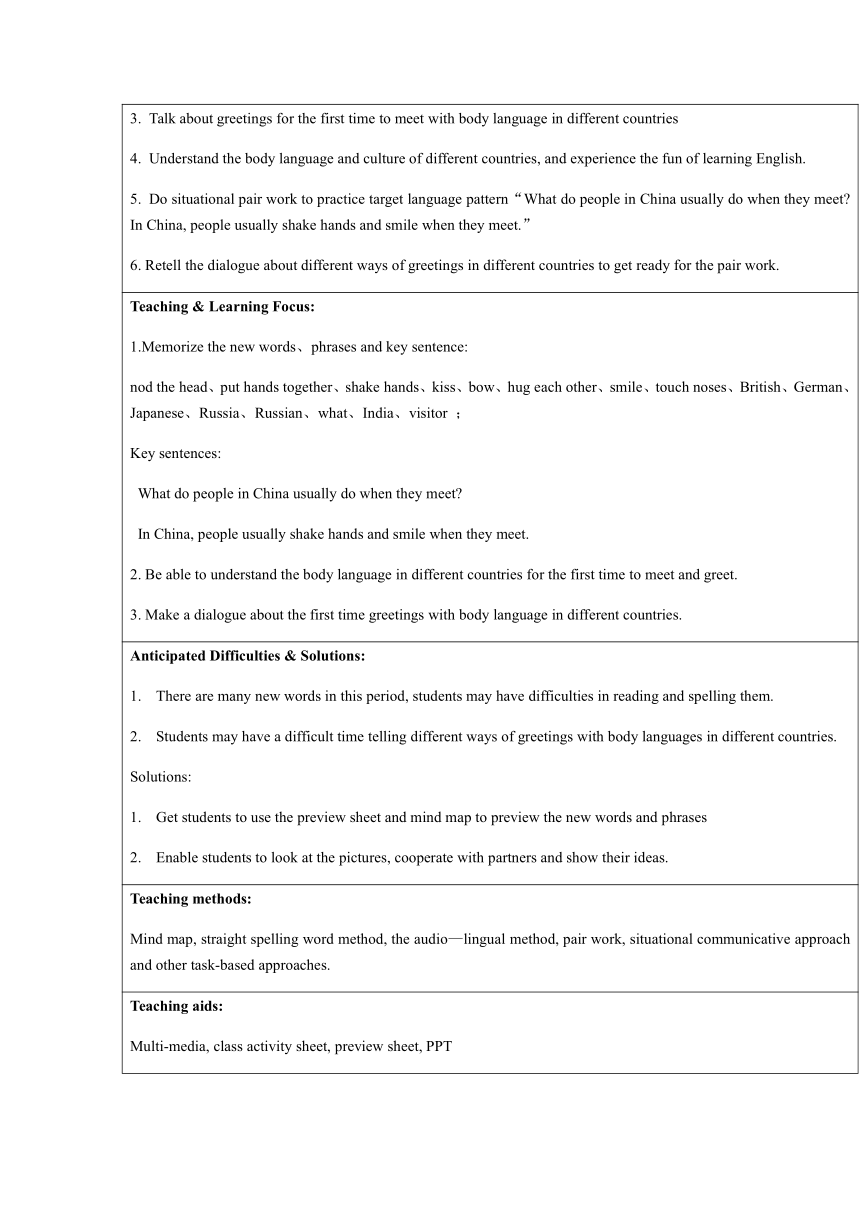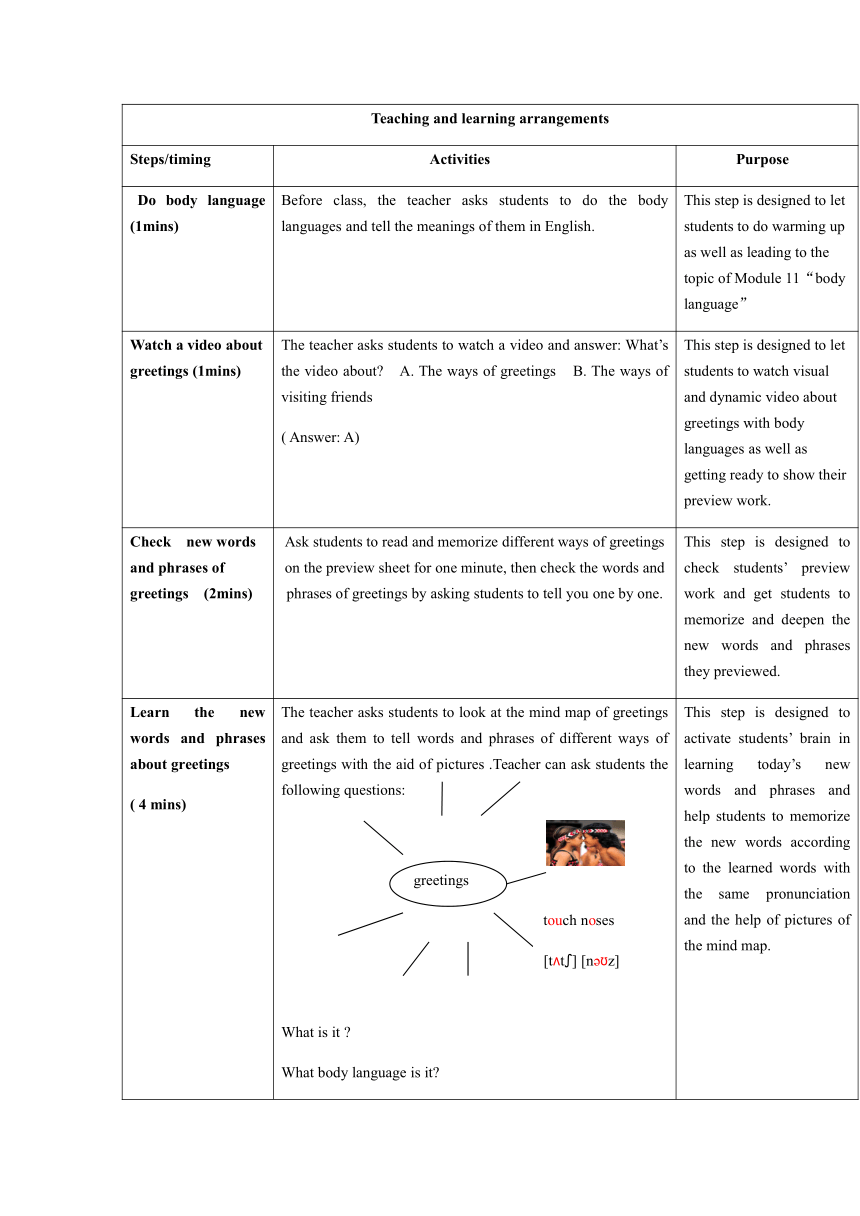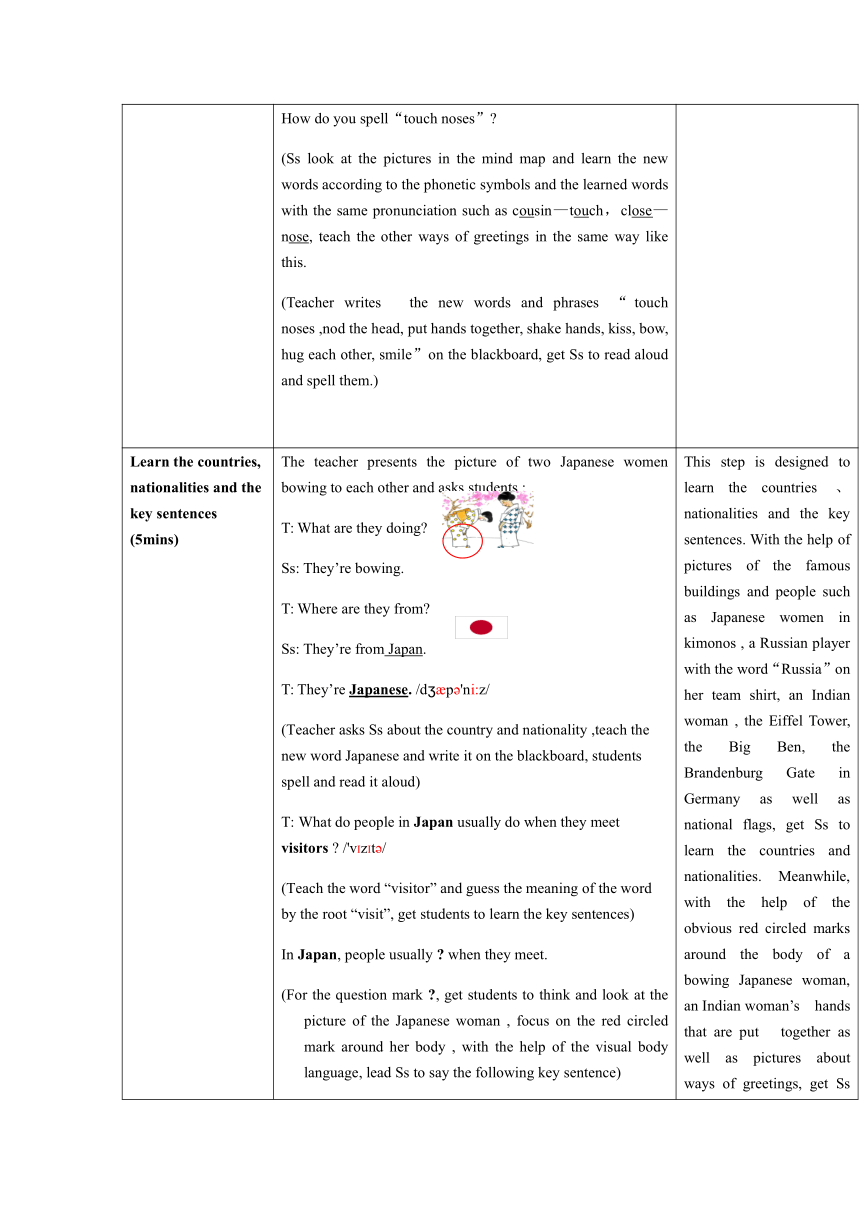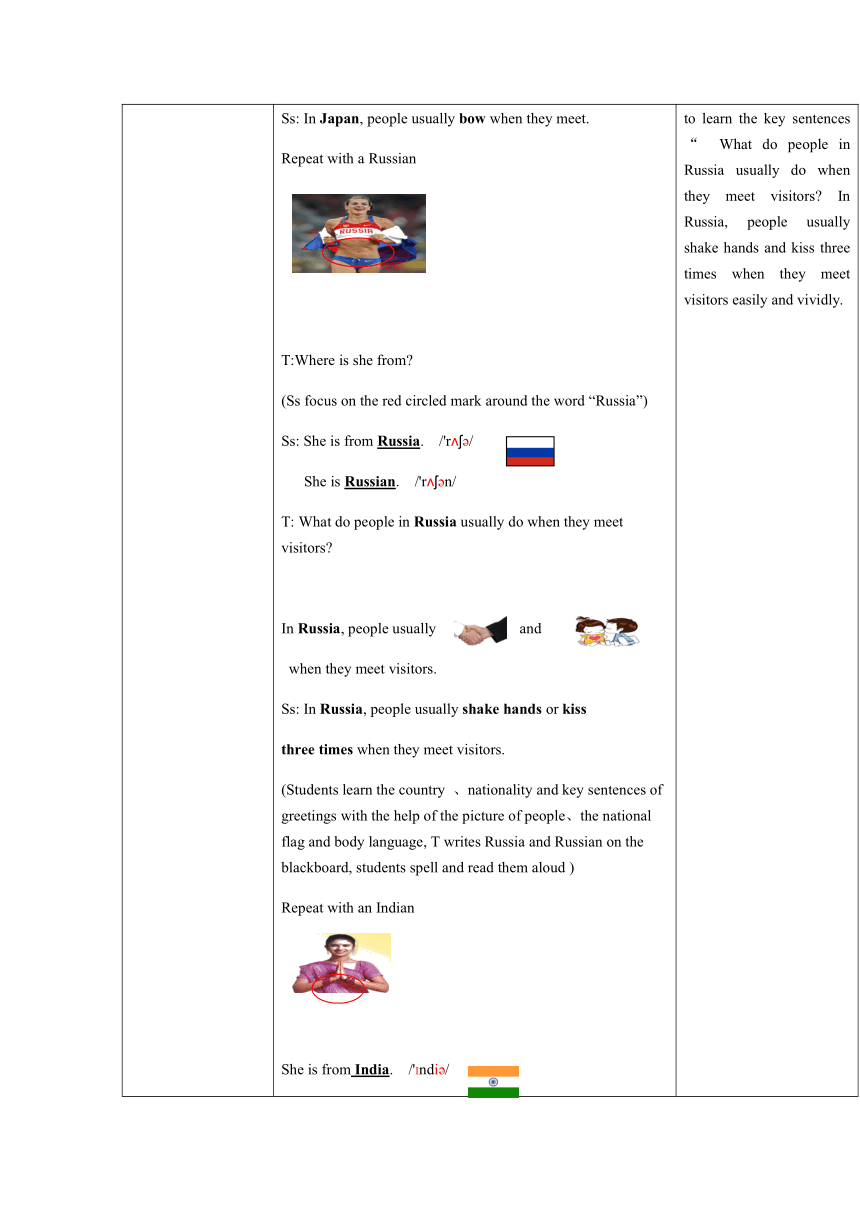外研版英语七年级下Module 11 Body language Unit 1 They touch noses!教案(1课时)
文档属性
| 名称 | 外研版英语七年级下Module 11 Body language Unit 1 They touch noses!教案(1课时) |  | |
| 格式 | zip | ||
| 文件大小 | 7.5MB | ||
| 资源类型 | 教案 | ||
| 版本资源 | 外研版 | ||
| 科目 | 英语 | ||
| 更新时间 | 2020-04-25 22:43:27 | ||
图片预览





文档简介
Module11 Unit1 They touch noses! (Listening and speaking)
Teaching Plan
Material Analysis:The topic of Module 11 is about body language. This period is mainly introduced different body languages and greetings in different countries for the first time to meet. This period consists of a listening material and a dialogue. The listening material and dialogue are about body languages and different ways of greetings in different countries for the first time to meet. In the dialogue, Lingling’s school is going to have some Russian teachers. Lingling and Betty are talking about different body languages and greetings of Chinese、 Russian、American、Indian and Maori people. As it is the first period of the first unit, listening 、understanding and talking about the topic“body language and greetings” play an important role in listening and speaking. Some proper tasks will be created to get students to practice the following skills, such as mind—map、 predicting the answers before listening、 pair work、reading aloud、 situational communication and so on.
Analysis of the students:Body language is an important form of expression and communication in our daily life. It also reflects the different cultures in different countries.?It is a topic that can arouse students' interest. Students in Grade7 may be interested in this topic, because the listening material and dialogue tell them different body languages and greetings for the first time to meet in different countries. Students always take an interest in body language. They are familiar with some body languages and the ways of greetings for the first time to meet in China. But they may not know the body language and greetings in other different countries. With the help of the Internet and preview sheet, students can know something about the body language and the first greetings in different countries. This helps students get well ready for the new lesson. Body language plays an important role in the international communication. Students would like to listen 、understand and talk about the topic “body language and greetings”.They will have a lot to say and they will talk freely and happily. Therefore, different tasks will be designed to equip the students with the topic.
Teaching Objectives:By the end of this session, most students will be able to understand the listening material and talk about the topic“body language and greetings”.Meanwhile, they will learn to use the mind map and preview sheet to memorize the words and phrases of greetings、countries and nationalities. Furthermore, they will learn to ask and answer about greetings for the first time to meet in different countries .. These will be achieved by the followingsUse mind map and the preview sheet to memorize the new words and phrases: nod the head、put hands together、shake hands、kiss、bow、hug each other、smile、touch noses、British、German、Japanese、Russia、Russian、what、India、visitor ....Understand the conversation of the body language in different countriesTalk about greetings for the first time to meet with body language in different countriesUnderstand the body language and culture of different countries, and experience the fun of learning English.Do situational pair work to practice target language pattern“What do people in China usually do when they meet? In China, people usually shake hands and smile when they meet.”6. Retell the dialogue about different ways of greetings in different countries to get ready for the pair work.
Teaching & Learning Focus:1.Memorize the new words、phrases and key sentence:nod the head、put hands together、shake hands、kiss、bow、hug each other、smile、touch noses、British、German、Japanese、Russia、Russian、what、India、visitor ;Key sentences:What do people in China usually do when they meet? In China, people usually shake hands and smile when they meet.2. Be able to understand the body language in different countries for the first time to meet and greet.3. Make a dialogue about the first time greetings with body language in different countries.
Anticipated Difficulties & Solutions:There are many new words in this period, students may have difficulties in reading and spelling them.Students may have a difficult time telling different ways of greetings with body languages in different countries.Solutions:Get students to use the preview sheet and mind map to preview the new words and phrasesEnable students to look at the pictures, cooperate with partners and show their ideas.
Teaching methods:Mind map, straight spelling word method, the audio—lingual method, pair work, situational communicative approach and other task-based approaches.
Teaching aids:Multi-media, class activity sheet, preview sheet, PPT
Teaching and learning arrangements
Steps/timing Activities Purpose
Do body language (1mins) Before class, the teacher asks students to do the body languages and tell the meanings of them in English. This step is designed to let students to do warming up as well as leading to the topic of Module 11“body language”
Watch a video about greetings (1mins) The teacher asks students to watch a video and answer: What’s the video about? A. The ways of greetings B. The ways of visiting friends( Answer: A) This step is designed to let students to watch visual and dynamic video about greetings with body languages as well as getting ready to show their preview work.
Check new words and phrases of greetings (2mins) Ask students to read and memorize different ways of greetings on the preview sheet for one minute, then check the words and phrases of greetings by asking students to tell you one by one. This step is designed to check students’ preview work and get students to memorize and deepen the new words and phrases they previewed.
Learn the new words and phrases about greetings( 4 mins) The teacher asks students to look at the mind map of greetings and ask them to tell words and phrases of different ways of greetings with the aid of pictures .Teacher can ask students the following questions: What is it ?What body language is it? How do you spell“touch noses”? (Ss look at the pictures in the mind map and learn the new words according to the phonetic symbols and the learned words with the same pronunciation such as cousin—touch,close—nose, teach the other ways of greetings in the same way like this.(Teacher writes the new words and phrases “touch noses ,nod the head, put hands together, shake hands, kiss, bow, hug each other, smile”on the blackboard, get Ss to read aloud and spell them.) This step is designed to activate students’ brain in learning today’s new words and phrases and help students to memorize the new words according to the learned words with the same pronunciation and the help of pictures of the mind map.
Learn the countries, nationalities and the key sentences (5mins) The teacher presents the picture of two Japanese women bowing to each other and asks students :T: What are they doing? Ss: They’re bowing.T: Where are they from?Ss: They’re from Japan. T: They’re Japanese. /d??p?'ni:z/(Teacher asks Ss about the country and nationality ,teach the new word Japanese and write it on the blackboard, students spell and read it aloud)T: What do people in Japan usually do when they meet visitors ? /'vIzIt?/ (Teach the word “visitor” and guess the meaning of the word by the root “visit”, get students to learn the key sentences)In Japan, people usually ? when they meet.(For the question mark ?, get students to think and look at the picture of the Japanese woman , focus on the red circled mark around her body , with the help of the visual body language, lead Ss to say the following key sentence)Ss: In Japan, people usually bow when they meet.Repeat with a Russian T:Where is she from?(Ss focus on the red circled mark around the word “Russia”)Ss: She is from Russia. /'r???/ She is Russian. /'r???n/T: What do people in Russia usually do when they meet visitors?In Russia, people usually and when they meet visitors.Ss: In Russia, people usually shake hands or kissthree times when they meet visitors.(Students learn the country 、nationality and key sentences of greetings with the help of the picture of people、the national flag and body language, T writes Russia and Russian on the blackboard, students spell and read them aloud )Repeat with an Indian She is from India. /'Indi?/She is Indian.What do people in India usually do when they meet visitors ?In India, people usually ? and when they meet visitors.(For the question mark ?,get students to think and look at PPT ,focus on the red circled mark around the Indian woman’s hands as well as the picture of nodding the head ,lead them to say the key sentences. )In India, people usually put hands together and nod heads when they meet.( T writes India and Indian on the blackboard, students spell and read them aloud )Teach nationalities “French,British,German” France T: Where is she from? ( Ask students to look at the building in the picture)Ss: She is from France. ( Help Ss to say)T: She is French. [ frent?]Repeat with British and German in the same way as French. the UK/ England Ss: She is from England/ the UK.T: She is British. ['brItI ∫] Germany Ss: She is from Germany.T: She is German. [d? ?:m ?n](T writes French、British and German on the blackboard, students spell and read them aloud .) This step is designed to learn the countries 、nationalities and the key sentences. With the help of pictures of the famous buildings and people such as Japanese women in kimonos , a Russian player with the word“Russia”on her team shirt, an Indian woman , the Eiffel Tower, the Big Ben, the Brandenburg Gate in Germany as well as national flags, get Ss to learn the countries and nationalities. Meanwhile, with the help of the obvious red circled marks around the body of a bowing Japanese woman, an Indian woman’s hands that are put together as well as pictures about ways of greetings, get Ss to learn the key sentences“ What do people in Russia usually do when they meet visitors? In Russia, people usually shake hands and kiss three times when they meet visitors easily and vividly.
Check the words of countries and nationalities( 2mins) T asks students to memorise the words of countries and nationalities for one minute, then check by showing them printed coloured national flags on the paper, get them to tell you the countries and nationalities one by one. This step is designed to check students if they haveremembered the words of countries and nationalities , get students to memorize and deepen the new words they learnt just now as well as getting ready for the listening and pair work.
Match the greetings with the pictures ( 1mins) Ask Ss to match the greetings with the right pictures.( Activity 1 on Page 66)After finishing, T checks the answers with Ss. Greetingsbow ① kiss ② shake hands smile ③ Matching the greetings with the right pictures can help Ss to deepen the memory of the greeting words.
Listen and match the nationalities with the pictures ( 3mins ) Get students to listen and match the nationalities with the pictures. (Activity 2) Nationality British ? French ? German ? Japanese Russian Before listening, get Ss to look at each picture and ask them:T: What are the people doing in Picture1/ Picture2/ Picture3 ?Ss: They’re kissing / shaking hands / bowing.T: What nationality are they in Picture1? (Let Ss guess)Ss: Are they British ? / French ? / German ? T: Maybe they’re … I don’t know. Let’s try to predict the answers before listening, get Ss to focus on the listening tip Tip1: try to predict the answers before listening Ask individual Ss to check the answers after they have finished listening. This listening activity aims at getting Ss to look at the five nationalities and three pictures, describe what people are doing in each picture , get Ss to look at Picture1 and guess “what nationality are they?”, in order to teach Ss the listening Tip1: try to predict the answers before listening as well as getting ready for practicing pair work.
Do pair work asking and answering about greetings and nationalities ( 4 mins) T gets Ss to look at the picture on the right and the model pair work ,ask and answer the model pair work with the Ss.A: What are they doing? B: They are kissing. A: Are they French ?B: Yes, they are./ No, they aren’t.T gives Ss more pictures to practice the pair work like the above model , then ask some pairs to show their pair work. After Ss showing their pair work, Teacher teaches “Maori” “ New Zealand” by presenting Ss the following picture and ask:T: What are they doing ?Ss: They are touching noses.T: Are they Indian, too?Ss: No, they aren’t.T: They are Maori people in New Zealand. ['ma?ri] ['z i?l?nd] This step is designed to let Ss practice asking and answering about ways of greetings and guessing the nationalities. With the help of national flags 、greetings with body languages and pictures of people, such as Japanese women in kimonos、the presidents Obama in the US and Vladimir Putin in Russia,Indian air hostesses It’s much easier and more interesting for Ss to do the pair work. They are more likely to do this. Meanwhile, leading Ss to learn the greeting of Maori people in New Zealand as well as learning new words“Maori”“New Zealand”
Listen and number the countries as you hear in Activity 3 ( 2mins) T: New Zealand is a country. What other countries are talked about in the following dialogue? (Activity3) Please listen to a dialogue between Betty and Lingling. They are talking about different ways of greeting in different countries. Get Ss to listen and number the countries as they hear.Number the countries as you hearChina New Zealand US Russia India Check the answers after Ss finish listening. This step is designed to let Ss get the first understanding of the dialogue in Activity 3, develop Ss’ skills of listening and understanding familiar topics ( greetings with body language), train Ss in order to enable them to understand the key and detailed information while listening.
Read the dialogue in Activity 3 and answer questions(2 mins) Get Ss to open their books, turn to Page 66, read the dialogue in Activity 3 and answer the following three questions.1.Who will come to Lingling’s school tomorrow? A. Russian teachers B. American teachers2. What do the US people usually do when they meet? (tick √ the answers)put hands together B. shake hands C. bowD. nod their heads E. hug each other F. kiss3. Maori people in New Zealand _____ when they meet visitors?A. B. C. D. After finishing, Teacher checks the answers by asking individual students to answer.As for Maori people touch noses, T says:T: Wow, that’s really an interesting way to greet people. Get Ss to feel the topic and read for the main content of the dialogue as well as reading for certain information . Ss can be trained to search for specific information in order to understand the dialogue further.
Listen and read after the recording in Activity3 ( 4 mins) T plays the recoding of the dialogue in Activity3 , Ss repeat after it one by one, try to imitate the pronunciation and intonation.After Ss repeat after the recording, ask them to read by themselves or role reading the dialogue. This step is created to help students to strengthen their understanding of the dialogue by listening and reading aloud after the recording as well as imitating the pronunciation and intonation. Allow Ss to fully practice the use of language by reading on their own or reading in roles.
Retell the dialogue in Activity3 with the help of the words in the box(4 mins) T: This time you know better about the greetings in different countries. Get Ss to retell the dialogue with the help of the words in the box.touch, shake, visitor, put, kiss, together, hug, smile, nodWhat do people in different countries do when they meet ___________? In China, people often __________ hands and __________. In Russia, people usually _______ three times. In India, people ________ their hands ___________ and ________ their heads. In the US, people shake hands ,and sometimes kiss or ______ each other. In New Zealand, Maori people _________ noses. So remember to do as Romans do when in Rome. Get individual Ss to tell the answers one by one. Through retelling the dialogue, deepen Ss’ understanding of the text, at the same time , sum up the dialogue and exercise the spoken language.
Moral education“When in Rome, do as Romans do.”(1 mins) Undertaking the last sentence in the above step “When in Rome, do as Romans do. ”People in different countries may use different body language. Try to understand them and respect them. (Moral education) This step is designed to get Ss to compare differences of body language in different countries. Understand the customs and cultures of different countries. Try to understand and respect their body language. Remember to do as Romans do when in Rome.
Situational pair work , use body language to ask and answer about ways of greetings in different countries. (7 mins) T: Now it’s our show time. Let’s do pair work. Suppose you are in an international class. Choose one country and tell us the ways of greeting in your country. Use body language to make it interesting if possible.Model: A: What do people in… usually do when they meet?B: In …, they …Before doing the pair work, T explains the requirements to the Ss, then the teacher asks a student to make a model pair work with her for the whole class. Finally T gets Ss to practice doing the pair work and ask several pairs to share their pair work with the class. CountriesWays of greetingIn ChinaIn the US In India In RussiaIn New Zealand (Maori People)In Japan This step is created to enable students to be active in class. It is good for improving students’ oral communication and also cooperating with partners. Furthermore, it created a language situation for Ss to practice using the target language. It is also designed to improve students’ speaking skills. Meanwhile, the pictures of ways of greetings can help students to do pair work better. To train students' ability to speak through the dialogue. Enable students to deepen the understanding of the content of the text The right amount of oral practice can help students to consolidate the language focus in this period..
Summary:words 、phrases and key sentences Ss have learned in this class.(2mins) Get Ss to sum up the greeting words and phrases、 countries 、nationalities and key sentences they have learnt in this class.New words and phrases: bow, kiss, shake hands, smile, nod the head, put hands together, hug each other, touch noses…Countries and nationalities: British, French, German, Japanese, India, Indian, Russia, Russian…Key sentences:What do people in China usually do when they meet?In China, people usually shake hands and smile. To sum up the new words, phrases and key sentences in this lesson, get students to consolidate what they have learnt today. Cultivate students' good learning habits of autonomous learning and independent summary .
Homework(1mins) T assigns two kinds levels of homework, Ss choose the suitable homework for themselves according to their learning base.Level A: Make a dialogue about ways of greeting in different countries.Level B: Surf the Internet to find more body language from other countries. Homework is an effective extension of classroom teaching. To consolidate what learnt today. Different homework for different levels of students is more suitable for them.
Blackboard Design:
Module11 Body language
Unit 1 They touch noses
British, French, German, Japanese, India, Indian, Russia, Russian…
Key sentences:
What do people in China usually do when they meet ?
greetings
touch noses
[t?t?] [n??z]
德国勃兰登堡门
①
②
③
2
1
4
3
…
Countries and nationalities:
In China, people usually shake hands and smile
同课章节目录
- Module 1 Lost and found
- Unit 1 Whose bag is this?
- Unit 2 Are they yours?
- Unit 3 Language in use
- Module 2 What can you do ?
- Unit 1 I can play the piano
- Unit 2 I can run really fast
- Unit 3 Language in use
- Module 3 Making plans
- Unit 1 What are you going to do at the weekends?
- Unit 2 We're going to cheer the players.
- Unit 3 Language in use
- Module 4 Life in the future
- Unit 1 Everyone will study at home
- Unit 2 Every family will have a small plane.
- Unit 3 Language in use
- Module 5 Shopping
- Unit 1 What can I do for you?
- Unit 2 You can buy everything on the Internet
- Unit 3 Language in use
- Module 6 Around town
- Unit 1 Could you tell me how to get to the Nationa
- Unit 2 The London Eye is on your right.
- Unit 3 Language in use
- Revision module A
- Module 7 My past life
- Unit 1 I was born in a small village.
- Unit 2 I was born in Quincy.
- Unit 3 Language in use
- Module 8 Story time
- Unit 1 Once upon a time….
- Unit 2 Goldilocks hurried out of the house.
- Unit 3 Language in use
- Module 9 Life history
- Unit 1 He left school and began work at the age of
- Unit 2 He decided to be an actor.
- Unit 3 Language in use
- Module 10 A holiday journey
- Unit 1 What did you do?
- Unit 2 This morning we took a walk.
- Unit 3 Language in use
- Module 11 Body language
- Unit 1 They touch noses!
- Unit 2 Here are some ways to welcome them.
- Unit 3 Language in use
- Module 12 Western music
- Unit 1 It's so beautiful!
- Unit 2 Vienna is the centre of European classical
- Unit 3 Language in use
- Revision module B
